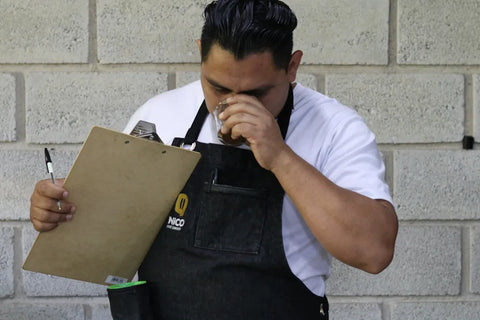All you need to know about Mexican coffee
If you wonder what position Mexico is in the coffee scene worldwide, we have some statistics to learn more about this Latin American coffee. You may discover a new favorite origin (in addition to African and Colombian coffees).
Mexican coffee key facts
- World ranking as an organic producer: 1st
- World ranking as a producer: 10th
- Percentage of the world market: 2.4%
- Processes: Washed, natural, semi-washed
- Varieties: 90% arabica bourbon, typica, caturra, mundo novo, maragogype, catimor, catuai, garnica, 10% robusta
- Hasvest: November- March
Currently, 12 producing states are recognized in Mexico, which in order of production volume, are:
- Chiapas
- Veracruz
- Oaxaca
- Puebla
- Guerrero
- San Luis Potosi
- Nayarit
- Tabasco
- Jalisco
- Colima
- Queretaro

Altitude.
About 70% of Mexican coffee is grown at 1,300-2,950 ft (400-900m).
Temperature.
All the coffee-growing regions generally have an average temperature of 17.5 to 25.3 C, (63.5- 77.5 F), similar to the optimum 18 to 22 C.
Notable producing regions:
Chiapas
Chiapas coffees are famous for their complexity and flavor, being the state with the highest production in Mexico, offering a mix of almost all varieties of Arabica, and characterized by having sustainable production systems (fair trade, organic, and under shade).
In Chiapas coffee, we can find spices, floral fragrances, nuances of pepper and piloncillo (cane sugar), caramel, nuts notes, and clean citric acidity.
With a good balance between sweetness, acidity, bitterness, and saltiness, extremely harmonious and exciting.
Veracruz
Its characteristics vary by region and altitude, cultivated in privileged areas such as Cordoba, Coatepec, Zongolica, Huatusco, Misantla, and Tuxtla.
In the Veracruz coffee, we can find high-quality coffees with a delicate flavor with sweet and fruity notes, an intense aroma with a floral fragrance and spices, medium to intense acidity, and a full to medium body.
Oaxaca
This state has various climatic conditions and altitudes; it has the most significant number of coffee municipalities, such as Miahuatlan, Loxicha, Ayutla, Juquila, Mixe, Papaloapan, Bule, Valle Nacional, among others.
Producer of the famous "Café Pluma" of excellent quality and international recognition since it has a denomination of origin and quality standard.
In Oaxaca, we can find complex coffee notes like spices, floral and fruity fragrances, sweet aromas like maple, piloncillo, and cinnamon, and light-bodied and robust notes of chocolate. The aftertaste is complex and of medium duration.
Puebla
Regions such as Xicotepec, Pahuatlan, Zihuateutla, Cuetzalan, Hueytamalco, and Zapapoaxtla stand out.
In general, the coffees produced in Puebla give us flavors of medium intensity with notes of spices, fruity, and chocolate, medium to pronounced body, medium acidity, and sometimes astringent in very high areas.
Guerrero
Regions recognized for their coffee: Atoyac de Alvarez, San Luis Acatlan, Remonta, and El Paraiso.
It is characterized by the production of its natural coffees, identified as the "Atoyac" type. It is highly valued and demanded internationally and nationally for its unique attributes with predominantly sweet notes and highly complex.
Generally full-bodied, very fruity berry-like, spicy, and floral, with a strong aroma of chocolate and a long aftertaste.

Shade grown coffee
More than 97% of the coffee in Mexico is grown under the shade of trees, which means it grows in harmony with its environment, which protects the soil from the loss of nutrients, deforestation, and numerous animal and plant species.
A coffee produced under the shade has a slower maturation process, which allows its organoleptic qualities to develop more.

Organic Coffee
Mexico is the country that produces the most recognized organic quality coffee.
The states of Chiapas and Oaxaca are the leading producers of this type of coffee, although we can also find them in other states in Mexico.
Generally, sensory attributes do not vary due to compliance with organic certification standards.
Coffee processes in Mexico
Coffee production in Mexico is divided into two main groups:
- Washed coffees constitute Mexico's primary type of coffee produced and exported. It represents about 86% of all produced in recent years.
-
Natural coffees from the dry method contribute 11% of the country's total production.
*Robusta coffee represents only about 3% of the national production.

Now you know better which regions of Mexico to try first, what kind of notes you can expect, and some interesting facts that make this country an excellent reason to start drinking specialty coffee.
Keep reading:
Killer Coffee at Farmer's Market in South Florida
Vegandale Fest Miami 2022
Latest Coffee Blog Posts

Our Coffee-Filled Adventure at Coffee Fest Orlando 2025
Coffee Fest Orlando 2025 brought together coffee lovers, roasters, and café owners for an unforge...
Read more →
Is there a sommelier for coffee?
Ever heard of a Q-grader? Often called a coffee sommelier, these certified professionals are the ...
Read more →
Which Coffee Roast Works Best with Your Machine?
The coffee roast you choose can make or break your brew. Learn which roast level pairs best with ...
Read more →